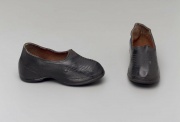Rubber (synthetic)
Description
Any man-made elastomer. The development of synthetic rubbers was stimulated when rubber imports ceased in 1941 due to Japanese occupation in southeast Asia. Within 3 years, US manufacturers had developed over nine types of elastomers. Most age better than natural rubber but are still susceptible to degradation by ozone and ultraviolet light. All rubbers must be chemically vulcanized to form an stable product. The unsaturated materials are vulcanized with sulfur while others are vulcanized with peroxide, metallic oxide, or diisocyanates. Examples of synthetic rubbers are: butadiene, styrene; Buna, nitrile rubber, SBR (styrene-butadiene rubber), ABS (acrylonitrile butadiene styrene), EPR (ethylene propylene rubber), EPDM (ethylene propylene diene), butyl rubber (isoprene), neoprene (polychloroprene), polysulfide, silicone (polysiloxane), epichlorohydrin, polyurethane.
Synonyms and Related Terms
synthetic rubber; caucho sintético (Esp.); caoutchouc synthétique (Fr.); gomma sintetica (It.); borracha sintética (Port.)
Examples: isoprene; butadiene; styrene; Buna; nitrile; SBR; ABS; EPR; butyl; neoprene; polysulfide;
Sources Checked for Data in Record
- Theodore J. Reinhart, 'Glossary of Terms', Engineered Plastics, ASM International, 1988
- M.Kaufman, The First Century of Plastics, The Plastics and Rubber Institute, London, 1963
- Pam Hatchfield, Pollutants in the Museum Environment, Archetype Press, London, 2002

